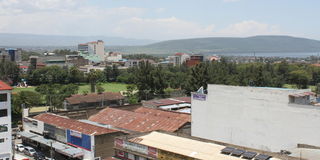Why Kuresoi North leads in teenage pregancies

An ariel view of Nakuru city.
Kuresoi North, Kuresoi South, and Njoro are the leading sub counties in Nakuru with a prevalence in teenage pregnancies.
Kuresoi North tops the list with a concerning 19.2 percent, followed closely by Kuresoi South at 18 percent. Njoro follows with a rate of 17 percent, highlighting an alarming trend in adolescent reproductive health.
This was revealed by the County Nursing Officer, Wendy Tirop after the launch of the Njoro youth-friendly centre.
"These numbers reflect a complex web of social challenges facing our youth," she says.
"Poverty, high school dropout rates, and cultural barriers to open discussions about sexual reproductive health have created a perfect storm for teen pregnancies."
She also points to other contributing factors such as poor communication between parents and children on sexual health, peer pressure, and substance abuse.
"Many parents struggle to discuss reproductive health with their children, leaving young people to rely on potentially misleading information from their peers," Tirop explains.
To address these challenges, the county has implemented several interventions.
Among them is the school health program which offers integrated services, including sexual reproductive health education, STI screening, and HIV counselling.
While emphasizing abstinence as the primary prevention strategy, the programs also provide comprehensive family planning information and antenatal care services.
Pregnant teens receive education about safe motherhood, with a particular focus on the importance of hospital deliveries.
Another is the Binti Shujaa program which involves teenage mothers sharing their experiences to discourage early pregnancies.
"When young mothers share their stories, it resonates more deeply with other teenagers. Other than that, they also guide other youth to avoid early pregnancies," Tirop notes. "We've also recruited young healthcare providers and counsellors who can better connect with youth."
The county has also engaged community leaders among them teachers to ensure consistent messaging about teen pregnancy prevention.
Additionally, peer educators provide counselling services to youth, creating a more approachable platform for discussing reproductive health issues.
The county provides two types of youth-friendly services.
First are the stand-alone centres, which are equipped with health services and recreational facilities, including darts, a pool, table tennis, and TV areas.
These centres attract hesitant youth, offering them a comfortable space to seek health services while keeping them engaged in constructive activities.
They are currently operational in six sub-counties: Njoro, Nakuru East—PGH, Gilgil, Naivasha, Molo, and Nakuru West.
The second type is integrated sites, where youth can access specialized youth-friendly services alongside regular hospital services within existing healthcare facilities.
Teenage pregnancy rates continue to be a concern across Nakuru County.
Molo records a 15.9 percent rate, Subukia 13.4 percent, and Rongai 13.2 percent.
Other affected areas include Gilgil at 11.7 percent, Naivasha at 10.8 percent, Bahati at 10.6 percent, Nakuru West at 10 percent, and Nakuru East with the least prevalence at 7 percent.
